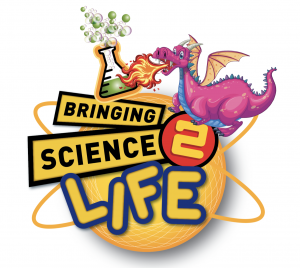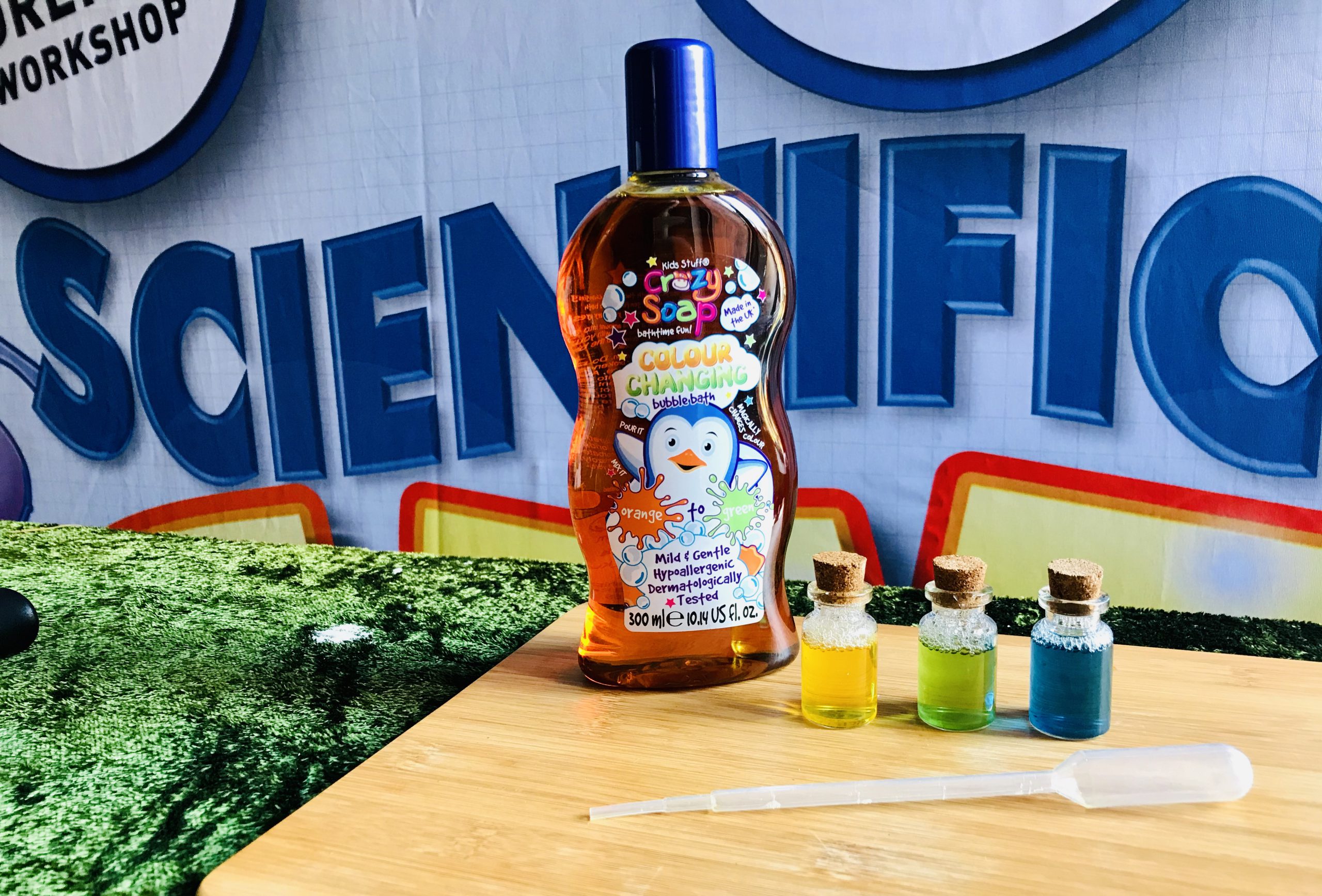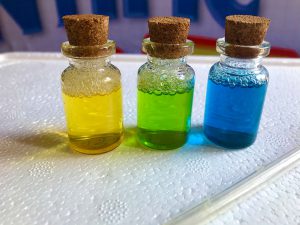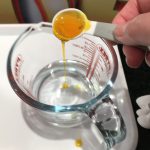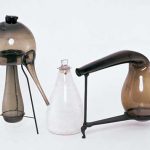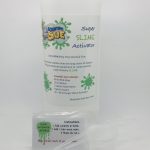Colour Changing Bubble Bath
Chemical: Bromocresol Green (BCG)
Science: Chemical Indicator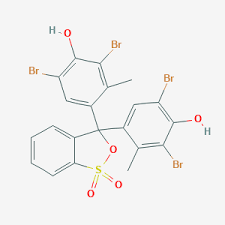
Bromocresol green is a dye of the triphenylmethane family and is used as a pH indicator in applications such as growth mediums for microorganisms and titrations. The most common use of BCG is to measure serum albumin concentration within mammalian blood samples in possible cases of kidney failure and liver disease.
However, for our use we are just going to explore it’s amazing colour changing properties!
Its chemical formula is C12H14Br4O5S
This means it is made up of 36 atoms. 12 Carbon (C), 14 Hydrogen (H), 4 Bromine (Br), 5 Oxygen (O) and 1 Sulphur (S).
In solution this dye gives us three colours: orange, green and blue.
Activity: Making a colour changing bath bomb!
Nuts & Bolts
- 1 ½ teaspoons (7.5ml) Crazy Soap: Colour changing bubble bath
- ½ teaspoon Citric acid
- 1 teaspoon Baking Soda
- 3 clear beakers
- 250 ml Water
- Stirrer
- Tray
Note clear vinegar could be used to replace the citric acid.
Secrets for Success
- Add 7.5 ml of the colour changing bubble bath to 250 ml of water. Stir the solution. You should see the bubble bath change colour from orange to green.
- Place 3 clear beakers on a tray
- Place ½ teaspoon of citric acid into one and 1 teaspoon of baking soda into another.
- Pour 50 ml of your green solution into the cup with the citric acid. What colour is it now?
- Pour 50 ml of your green solution into the cup with the baking soda. What colour is it now?
- Stir both beakers making sure all of the chemicals are mixed thoroughly.
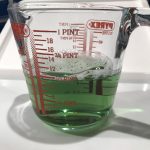
- Lift the two beakers and slowly pour them into the third, empty beaker. Colour changes will occur plus lots of carbon dioxide will be formed which will bubble through the soapy liquid forming lots of foam!
Science in a Nutshell
When atoms (or groups of atoms) lose or gain electrons, charged particles called ions are formed. Ions can be either positively (lost electrons) or negatively (gained electrons) charged.
Acids When acids dissolve in water they produce hydrogen ions, H+.
Alkalis When alkalis dissolve in water they produce hydroxide ions, OH–.
Base A base is chemically opposite to an acid. Some bases dissolve in water and are called alkalis. But other bases, including many metal oxides, do not dissolve in water.
Neutralisation Reaction
When the H+ ions from an acid react with the OH– ions from an alkali, a neutralisation reaction occurs to form water. This is the equation for the reaction:
H+(aq) + OH–(aq) → H2O(l)
For example, hydrochloric acid and sodium hydroxide solutions react together to form water and sodium chloride solution. The acid contains H+ ions and Cl– ions, and the alkali contains Na+ ions and OH– ions. The H+ ions and OH– ions produce the water, and the Na+ ions and Cl– ions produce the sodium chloride, NaCl(aq).
A pH Indicator is a chemical compound added in small amounts to a solution so the pH (acidity or basicity) of the solution can be seen. The pH indicator is a chemical detector for hydronium ions (H3O+) or hydrogen ions (H+). Normally, the indicator causes the colour of the solution to change depending on the pH.
Typical indicators are phenolphthalein, methyl orange, methyl red, bromothymol blue, and thymol blue. They each change colour at different points on the pH scale, and can be used together as a universal indicator.
Bromocresol Green as an indicator is yellow in colour for pH values below 3.8; green between pH values of 3.8 and 5.4 and blue for pH values above 5.4.
What does pH mean for water?
Basically, the pH value is a good indicator of whether water is hard or soft. The pH of pure water is 7. In general, water with a pH lower than 7 is considered acidic, and with a pH greater than 7 is considered basic. The normal range for pH in surface water systems is 6.5 to 8.5, and the pH range for groundwater systems is between 6 to 8.5.
What does pH mean for our bubble bath?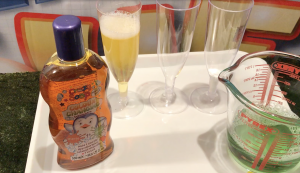
Citric acid is added to the bubble bath in a quantity which reduces the bubble bath solution to that below a pH of 3.8. With the bromocresol added this makes the bubble bath an orange/yellow colour.
As water is added to the bubble bath the pH of the solution will gradually increase. When it is between 3.8 and 5.4 the solution is green in colour.
However, the amount of water in a bath far exceeds the small quantity required for this pH range. The pH of the bath water will be greater than 5.4 which means we will see the blue colour of the bromocresol green indicator dye.
What happens when we mix our bubble bath solutions with citric acid and baking soda?
When the yellow citric acid solution is mixed with the blue baking soda solution (sodium hydrogen carbonate) a 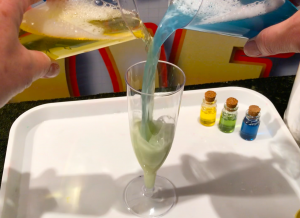 chemical reaction takes place. Lots of carbon dioxide bubbles are formed in a very short period of time – and by carefully mixing them we can achieve the green colour again!
chemical reaction takes place. Lots of carbon dioxide bubbles are formed in a very short period of time – and by carefully mixing them we can achieve the green colour again!
This experiment is an example of a reaction between an acid (citric acid) and a base (baking soda). Such reactions typically form a “salt” and water.
ACID + BASE –> SALT + WATER
Because the acid component in this experiment is citric acid, it allows the production of one of the products to be sodium citrate. That is the stuff referred to as the “salt.” In this experiment, the base (sodium hydrogen carbonate) has a carbonate component; hence carbon dioxide is also formed.
The fancy shorthand symbols used by scientists to represent our reaction are:
C6H8O7 + 3NaHCO3 –> Na3C6H5O7 + 3H2O + 3CO3
Citric acid + sodium hydrogen carbonate makes sodium citrate + water + carbon dioxide
(baking soda)
This reaction is rapid and the bubble mixture foams up really quickly.
Citric acid is a common ingredient in citrus-flavoured foods. Have your children look for it in the ingredient lists on sweets and soft drinks.
Carbon dioxide in liquid form is found in many fire extinguishers. For it to be liquid it is kept at certain pressures and temperatures; an extinguisher can only be used once for this reason.
When released the liquid CO2 quickly changes into a gas. This gas is heavier than air and sinks downwards. If aimed correctly the gas forms a blanket covering over the fire thus blocking out the oxygen required for combustion. The fire is extinguished.
Everything is made of chemicals, and all chemicals are made of tiny particles called atoms. During a chemical reaction, one group of atoms are shuffled and taken apart, they get mixed with the other atoms to form a different group and make a new chemical. Similarly, when citric acid is mixed with bicarbonate of soda (baking soda) one of the new chemicals formed is the gas CO2.
